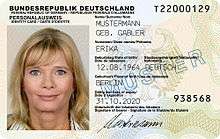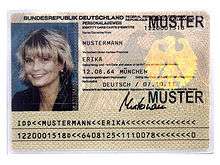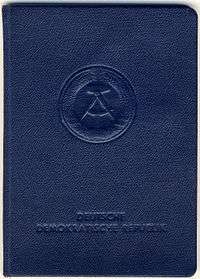German identity card
| German identity card | |
|---|---|
 Specimen of the credit-card sized German identity card issued since 1 November 2010 | |
| Issued by |
|
| Valid in |
|
| Type of document | Compulsory identity document |



The German Identity Card (German: Personalausweis) is issued to German citizens by the local registration offices and diplomatic missions abroad (although today they are produced centrally at the Bundesdruckerei in Berlin).
Obligation of identification
According to the German law of obligation of identification, it is compulsory for all German citizens age 16 or older to possess either an identity card or a passport. While police officers and some other officials have a right to demand to see one of these documents, the law does not stipulate that one is obliged to submit the document at that very moment.
As everyone in Germany must possess an ID card or a passport, acceptance of other official documents (like driving licences) as proof of identity is not guaranteed, especially for old driving licences with less security. Driving licences issued before 2013 are not replaced in Germany, so the same document is kept.
German citizens travelling inside Europe (except Belarus, Russia and Ukraine) or to Egypt, Georgia, Turkey and on organized tours to Morocco and Tunisia can use their ID card, which is a machine-readable travel document, instead of a passport.[1]
Just like German passports, German identity cards are valid for ten years (six years if the holder is under 24 on the date of issue).
The ID card currently costs €28.80 (€22.80 if the holder is under 24 on the date of issue).
History
In 1938 the Nazis obliged men of military age and Jews (who had a 'J' marked on their card) to carry identity cards.[2] Shortly after the start of the war, this was extended to apply to all citizens over the age of 15.
In 1951 both the West German and the East German authorities began issuing booklet identity cards in the ID-2 format.
In West Germany an improved identity card was developed in the 1980s and issued from April 1987 on. The card consisted of a single laminated sheet of paper with a machine-readable zone. To prevent counterfeiting, it contained watermarks, guillochés, microprinting, fluorescent dyes, and multi-colour fluorescent fibres. In addition, the holder's name was laser engraved into the plastic film and the holder's picture was printed on the document, so it could not be removed and replaced by a different one (unlike the older ID cards, where the picture was just glued to the document).
When East Germany joined West Germany on 3 October 1990, the West German identity card was introduced in the former East German territory; unexpired East German identity cards could still be used until 31 December 1995.
In November 2001, the so-called Identigram feature was added - a number of holographic security elements, including a three-dimensional German Eagle, a holographic copy of the holder's picture (the so-called Holographic Shadow Picture), a holographic copy of the machine-readable zone, holographic microprinting, and kinematic elements.
The current ID-1 type has been issued since November 2010. It contains an RFID chip similar to that in biometric passports. The chip stores the information given on the ID card (like name or date of birth), the holder's picture (which, unlike the picture on older ID cards, has to be a biometric one), and, if the holder wishes so, also his/her fingerprints. In addition, the new ID card can be used for online authentication (such as for age verification or for e-government applications). An electronic signature, provided by a private company, can also be stored on the chip.
Physical appearance
.jpg)
The current ID card is an ID-1 (credit card size) plastic card with an embedded RFID chip. It is covered with multi-colour guillochés and appears green-brown from a distance. All the information on it (except for colour of eyes) is given in German, English, and French.
Front side
The front side shows the German Eagle and the words "BUNDESREPUBLIK DEUTSCHLAND / FEDERAL REPUBLIC OF GERMANY / REPUBLIQUE FEDERALE D'ALLEMAGNE" and "PERSONALAUSWEIS / IDENTITY CARD / CARTE D'IDENTITE". It contains the following information:
- Photo of ID card holder (biometric photo)
- Document number (9 alphanumeric digits)
- Access number for RFID chip (6 decimal digits)[3]
- Surname
- Given name(s)
- Date of birth (dd.mm.yyyy)
- Nationality (DEUTSCH)
- Place of birth (Only the city/town of birth, no country)
- Date of expiry (dd.mm.yyyy)
- Signature of holder
Rear side
The rear side shows the Brandenburg Gate. It contains the following information:
- Colour of eyes
- Height in cm
- Date of issue (dd.mm.yy)
- Issuing authority
- Residence (postal code, town, street, house number)
- Religious name or Pseudonym (only if holder has one)
- Machine-readable zone
Machine-readable zone
The three-line machine-readable zone on the back side contains the following information:
First line
| positions | text | meaning |
|---|---|---|
| 1-2 | ID | identity document |
| 3 | D | issuing country: Germany (Deutschland) |
| 6-14 | alphanumeric digits | document number |
| 15 | decimal digit | check digit over 6-14 |
Second line
| positions | text | meaning |
|---|---|---|
| 1-6 | decimal digits | date of birth (YYMMDD) |
| 7 | decimal digit | check digit over 1-6 |
| 9-14 | decimal digits | date of expire (YYMMDD) |
| 15 | decimal digit | check digit over 9-14 |
| 16 | D | nationality of holder: German (Deutsch) |
| 30 | decimal digit | check digit over 6-30 (upper line), 1-7, 9-15, 19-29 (middle line) |
Third line
| positions | text | meaning |
|---|---|---|
| 1-30 | alphabetic digits<<alphabetic digits<alphabetic digits | SURNAME<<GIVEN<NAMES |
Empty spaces are represented by "<".
Different spellings of the same name within the same document
- German names: German names containing umlauts (ä, ö, ü) are spelt correctly outside of the machine readable zone, but with simply the vowel + E in that zone Similarly, the German letter ß becomes SS in the machine readable zone. For example, Müller becomes MUELLER, Groß becomes GROSS, and Gößmann becomes GOESSMANN.
- The transcription mentioned above is generally used for air tickets etc., but sometimes (like in US visas) also simple vowels are used (MULLER, GOSSMANN). The three possible spelling variants of the same name (e.g. Müller / Mueller / Muller) in different documents sometimes lead to confusion, and the use of two different spellings within the same document (like in the German ID card or the German passport) may give people who are unfamiliar with the German orthography the impression that the document is a forgery.
- Some German names are always spelled with the "transcription" such as the poet Johann Wolfgang von Goethe or the Nazi politician Paul Joseph Goebbels; however, in the name of the former German football player Ulrich Hoeneß, the umlaut is transcribed, but the letter ß is not (the spelling in the machine-readable zone is HOENESS, the ß being transcribed here).
- Non-German names: In some names of naturalized citizens, some special letters that are not available may always be replaced by simple letters, including outside of the machine readable zone. The "Bundesdruckerei AG," which prints the German passports, uses the character set String.Latin (earlier: LA8 Passport), which includes a Latin subset of the Unicode characters (ISO 10646), so that letters such as ł and ç can be displayed in the non-machine-readable zone. When in doubt, consult the "Bundesdruckerei AG". Names originally written in a non-Latin writing system may pose another problem if there are no internationally recognized transcription standards. For example, the Russian name Горбачёв is transcribed "Gorbachev" in English, "Gorbatschow" in German,"Gorbatchov" in French, "Gorbachov" in Spanish, and so on. A Russian person with a Russian passport would have a transliteration in the passport based on English, like Gorbachev. A Russian person who has got a German passport would usually have a transliteration based on German, like Gorbatschow.
Chip
Newer ID cards contain an ISO 18000-3 and ISO 14443 compatible 13.56 MHz RFID chip that uses the ISO 7816 protocols.[4][5] The chip stores the information given on the ID card (like name or date of birth), the holder's picture and, if the holder wishes so, also his/her fingerprints. In addition, the new ID card can be used for online authentication (e.g. for age verification or for e-government applications). An electronic signature, provided by a private company, can also be stored on the chip.
The document number, the photo and the fingerprints can supposedly be read only by law enforcement agencies and some other authorities.[6] All ID card agencies have been supplied with reading devices that have been certified by the German Federal Office for Information Security (BSI). Agency staff can use these modules to display all of the personal data stored on the chip, including the digital passport photo and, where applicable, the stored fingerprints.[7]
To use the online authentication function, the holder needs a six-digit decimal PIN. If the holder types in the wrong PIN, he has to type in the six-digit decimal access code given on the ID card to prove he/she really possesses the ID card. If the wrong PIN is used three times, a PUK must be used to unlock the chip. The data on the chip are protected by Basic Access Control and Extended Access Control.
Security features
The identity card contains the following security features:
- multicoloured guillochés
- microprinting: BUNDESREPUBLIK DEUTSCHLAND
- fluorescent elements which luminesce in various colors under UV light:
- UV overprint:
- eagles and BUNDESREPUBLIK DEUTSCHLAND (in macroprinting): red-orange
- BUNDESREPUBLIK DEUTSCHLAND BUNDESREPUBLIK DEUTSCHLAND BUNDESREPUBLIK DEUTSCHLAND (in microprinting): yellow
- guillochés: turquoise
- randomly distributed fluorescent fibres: red, yellow, turquoise
- UV overprint:
- tactile features:
- access number for RFID chip and date of expire are tactile
- surface embossing: map of Germany and microlettering BUNDESREPUBLIK DEUTSCHLAND
- security thread: colour changes when viewed under different angles; is personalized: NNNNNNNNNN<<SURNAME<<GIVEN<NAMES<<<<<<<<<< (NNNNNNNNNN is the document number including a check digit; a total of 42 digits can be found on the thread))
- changeable laser image: shows either the date of expire or the holder's portrait depending on angle
- color-changing ink: the colour of the text BUNDESREPUBLIK DEUTSCHLAND changes from black to green to blue
- 2D and 3D holographic security elements:
- colour-changing holograms: colour changes depending on angle (violet-blue-turquoise-green-yellow-orange-red)
- holographic portrait: holographic reproduction of the holder's picture
- four eagles at the left side of the holographic portrait: change their colour under a different angle than the portrait itself
- document number: NNNNNNNNN, 9 digits
- holder's name: SURNAME<<GIVEN<NAMES<<<<<<<<<<, 30 digits
- green kinematic structures above the conventional picture:
- eagle: bright eagle on dark hexagon changes to dark eagle on bright hexagon to letter D in hexagon when document is tilted
- hexagon: moves across the picture when document is tilted
- stars: change their size when document is tilted
- letter D: moves across the picture and turns into a star
- text on the left side of the picture; visible only under a certain angle
- macrolettering: BUNDESREPUBLIK DEUTSCHLAND
- microlettering: BUNDESREPUBLIK DEUTSCHLAND BUNDESREPUBLIK DEUTSCHLAND BUNDESREPUBLIK DEUTSCHLAND
- machine-verifiable structure: a red spot which can be checked by machines
- 3D eagle: a red-gold eagle visible only under a certain angle
- colour-changing holograms: colour changes depending on angle (violet-blue-turquoise-green-yellow-orange-red)
Gallery: Old East German ID card
See also
- German passport
- German residence permit (identity document for non-EU citizens living in Germany)
- Kennkarte (identity document used in Nazi Germany)
- National identity cards in the European Union
References
- ↑ Reise- und Sicherheitshinweise A-Z (German)
- ↑ "The Nuremberg Race Laws".
- ↑ This number should be blackened out when making copies of the ID card, according to the official instructions
- ↑ Fumy, Walter; Paeschke, Manfred (eds.). Handbook of EID Security: Concepts, Practical Experiences, Technologies. p. 49. ISBN 978-3-89578-658-7.
- ↑ Hochstätter, Christoph H. (23 June 2010). "Neuer Personalausweis: Wo die wirklichen Gefahren lauern" [New Identity Card: Where are the real dangers lurk]. ZDNet.
- ↑ personalausweisportal.de FAQ (German)
- ↑ http://www.london.diplo.de/contentblob/3778704/Daten/2959228/eIDFAQs.pdf
External links
| Wikimedia Commons has media related to Personalausweis (Germany). |
- General information about the new German ID card on personalausweisportal.de (German)
- General information about the new German ID card on bundesdruckerei.de (English)
- Security features of the new German ID card on bundesdruckerei.de (English)
- Security features of the 1987-2001 ID card on PRADO (English)
- Security features of the 2001-2010 ID card on PRADO (English)
- Security features of the current ID card on PRADO (English)





